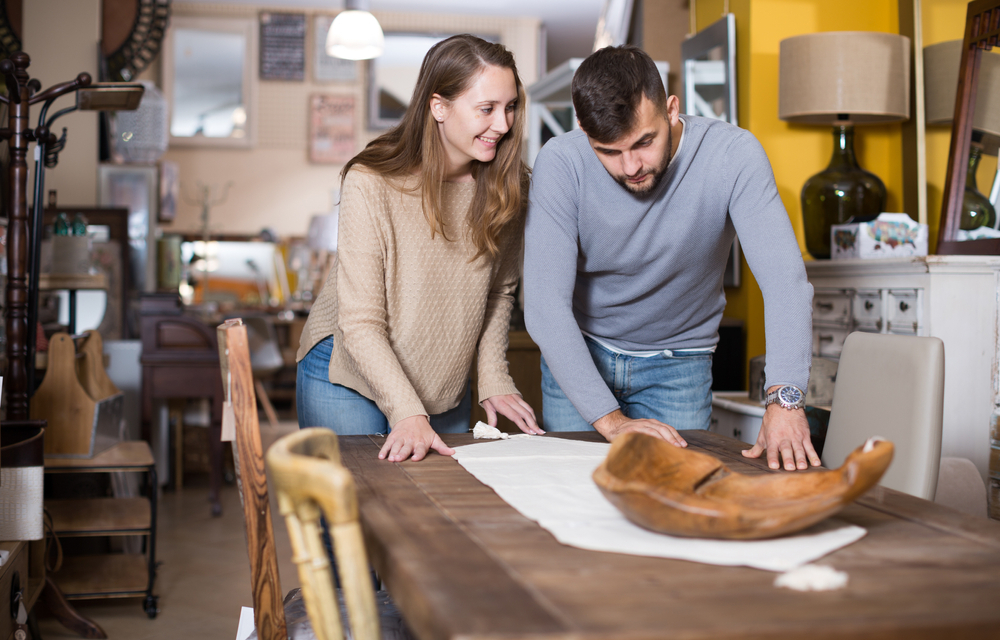
How to Sell Old Furniture

Grandma’s vintage armoire, a rustic pine coffee table, the smelly mattress you bought from a roommate back in Boulder—what do these pieces of old furniture have in common? That’s right: You desperately want to declutter your home and get rid of them.
Whether you’re upgrading your apartment or looking for the best place to get rid of items that don’t fit in your new space, learning how to sell old furniture to a new owner is a skill that will benefit you for a lifetime. As the old adage goes, one man’s trash is another man’s treasure!
If you want to learn more about the best way to sell furniture, read on for a few tips and tricks, including how to:
- Know your worth
- Show marketplace savvy
- Sell well
- Start accepting offers
Let’s get started!
Step 1: Know your worth
Before getting into the “how” of selling, let’s talk a little bit about what to sell. Deciding what to sell, keep, or send to the landfill means knowing the value and worth of your piece.
What exactly do we mean by worth and value? When talking about old furniture, sellers should keep a few things to keep in mind: value and worth. Value is the likelihood the item will resell, based on supply and demand, brand name, condition, and location. Worth, on the other hand, is the probable selling price of the piece of furniture.
Old furniture you should consider reselling are items that have retained some modicum of value (meaning they’re likely to sell) and will bring in enough money to make the effort of selling worthwhile.
So, while you may have loved your old mattress or sprung-cushion couch, you aren’t likely to resell them if they aren’t in good condition. In these cases, you should consider either donating old and worn items or tossing them.
On the other hand, while some furniture is easy to let go (buh-bye, broken IKEA coffee tables and bent-leg Walmart chairs!), it can be tricky to decide the fate of other secondhand furniture, such as a hand-me-down antique from a treasured relative or a piece you love but don’t have room for any more. In these cases, you might want to consider storing your unwanted furniture or stowing it away with a close friend until you’re ready to take it back.
If, however, your old furniture has retained some value and you no longer desire to keep it, it’s time to sell.
The art of appraisal
Appraisal is just a fancy way of saying, “What is this worth?” Remember, worth means a probable price and is only a ballpark figure.
Special and unique furniture, like Grandma’s vintage armoire, might be hard to appraise yourself and could benefit from a professional appraisal. However, most newer furniture can be assessed with nothing more than a quick internet search, a trip through a secondhand furniture store, or a visit to an online marketplace.
There are a few ways sellers can adequately gauge the value of their furniture:
- Google it: If you bought your furniture new and relatively recently, a quick trip to the internet will give you a pretty good idea of a worthy sale price. A basic guideline is that high-quality consignment furniture in good or excellent condition retains about 70% of its purchase price.
- Do a little legwork: There are two types of furniture stores sellers can visit to help price an item for resale:
- Retailers: If you purchased your furniture in a store, revisit it (or a similar retailer) to see what they are currently selling and what newer designs sell for.
- Secondhand shops: By visiting a thrift shop or consignment store, you’ll get the strongest sense of what the market is for a used piece in a condition similar to yours.
- Professional advice: If your old furniture item is truly unusual, designer, vintage, or antique, you might consider paying a professional appraiser to give you a sense of its market value. Finding a local appraiser can be achieved by visiting the website of one of the three major appraiser organizations:
Step 2: Show marketplace savvy
Once you’ve decided what to sell and what its worth is to you, it’s time to find the best marketplace for your piece. Where you sell your old furniture largely depends on the type of furniture you’re selling, but for the most part, there are three basic ways to sell:
- Online
- Brick-and-mortar store
- Yard sale
1. Selling old furniture online
It used to be that you could only sell old furniture at yard sales, estate sales, and through thrift stores or antique stores. However, the internet has quickly surpassed those venues as a powerhouse hub of secondhand furniture sales.
Whether you want to offer a unique piece to a global audience or an ordinary piece to your neighbors or local buyers, some of the best online sites for old furniture sales include:
You can also go old school with online newspaper classifieds. Some local newspapers continue to maintain a classified section where you can advertise your items. Check both your local newspaper and any alternative papers in your area for this hyper-local approach.
A few important words of caution about selling furniture online
When selling furniture online to strangers, there are several precautions you must take. Not only must you be aware of potential scams buyers leverage and know how to avoid them, but you also must take personal safety measures when meeting a potential buyer.
- Avoid scams: When you choose a website to use for offering your old furniture online, take a quick look at their safety section so you know how to avoid the latest scams. Although most buyers are legitimate and trustworthy, a few potential red flags are:
- Buyers asking for communication outside the website’s platform
- Buyers asking to pay with a check, cashier’s check, wire transfer, or money order
- Buyers asking for your financial information
- Buyers sending emails or texts from outside your area (especially internationally)
- Buyers using poor grammar or having a vague understanding of the item
- Personal safety: To transfer your used furniture to a new owner locally, you will have to meet physically. Trust your gut about anything fishy when communicating with a potential buyer and always:
- Meet in a public place
- Carry your cell phone
- Bring a friend or two to the meeting or pickup
2. Selling old furniture through a brick-and-mortar store
If the stress and hassle of online sales aren’t for you, there are still options for selling your old furniture. Note, however, that all of these venues will charge selling fees for your items. As such, find out their terms and conditions before you agree to sell through places like:
- Thrift shops
- Secondhand store or a consignment shop
- Auction houses
3. Facilitating your own sales
If you’re really making big changes and have many items to sell, consider holding a garage sale or yard sale. Be aware that this can be a lot of work, from advertising your sale and setting it up to bargaining prices and doing the final clean-up.
The upside is that you keep all the profits and have the satisfaction of watching your pile of undesirables shrink away.
Step 3: Sell well
It’s tempting to snap a quick pic of your old dresser covered with dust and leaking socks from askew drawers, but it will behoove you in the long-term to spend a few minutes getting your old furniture looking its best before trying to sell it.
While you’ll want to display your item aesthetically, you’ll also want to show it authentically to ensure potential buyers know what they’re getting. That means divulging any damage, such as scratched paint or dents.
Prep work
Here are a few tips for getting your old furniture looking its best and most well-maintained:
- Vacuum away any dust or stray pet hairs from the item
- Wash, clean, or wax your furniture as needed
- Buff out scratches and clean away stains
- Depersonalize it (no photos on shelves or kitschy cushions on couches)
Photography know-how
When photographing your old furniture, consider the following:
- Take the photos in a bright room lit by natural light
- Remove or minimize anything distracting from the photo, if possible
- Photograph the item against a white or monochrome background
- Photograph the furniture from many different angles to show scale and perspective, including above, below, close up, and far away.
Descriptions matter
In addition to posting photos of your old furniture, you’ll also need to write a catchy description that touches on the item’s most important features and discloses any flaws. Some important considerations for this include:
- Use your best grammar to show professionalism
- Keep the description concise but detailed, including such things as:
- Color
- Style
- Dimensions
- Brand
- Age
- Condition
- Disclose flaws such as nicks, scratches, dents, or missing parts
Step 4: Start accepting offers
So, you’ve done the hard work of evaluating your furniture, cleaning it up, and posting it online for sale. Now let the offers roll in, right?
Well…maybe.
Sometimes a piece of old furniture will sell quickly and easily (especially if it’s priced well), but other times, sellers are destined to enter the purgatory of negotiation with a potential buyer.
Knowing how to negotiate on price and other factors and when to walk away can be tricky. To that end, when entering the negotiation process, there are a few things you should keep in mind:
- Have a walkaway price: Set a baseline for how low you’re willing to sell your item. If a potential buyer isn’t willing to pay for the item’s value, it’s best to move on to a different prospect.
- Don’t get emotional: When negotiating, stay even-keeled, professional, and composed.
- Make concessions: If you’re selling a furniture set, selling a damaged item, or looking to sell your item quickly, consider making certain concessions such as marking down the price, offering delivery, or arranging a no-contact pickup for the convenience of the buyer.
Hassle-free moving with Landing
Whether you have a single piece of old furniture to unload or a whole houseful, selling it can be both gratifying and profitable. On the other hand, if you move frequently, the carousel of purchases and sales can get pretty exhausting.
At Landing, we’ve created a model for moving that eliminates all your furniture-sales woes.
We’ve reinvented apartment living with our national network of beautifully fully furnished apartments—where you can feel at home instantly. From luxurious sleep details to fully-equipped kitchens, each of our homes will have you feeling comfortable and secure from the moment you walk through the door.









